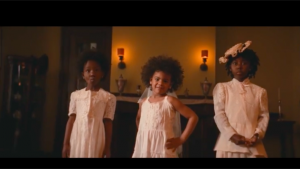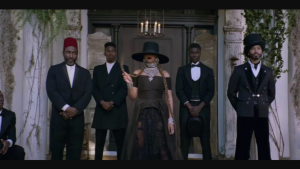by Cord J. Whitaker
The internet has been abuzz with commentary on Beyoncé’s new surprise video “Formation.” Critics have discussed it as Beyoncé’s most explicit proclamation of her blackness. In one lyric, she identifies carrying hot sauce in her bag as swag. One critic identifies this as not Pharrell’s “new black” but rather your grandmother’s black. Another critic, Yaba Blay, notes that Beyoncé is at her “blackest blackity black” blackest. At the same time, Blay smartly notes the colorism that attends Beyoncé’s identification of herself as a mix of her mother’s Creole Louisianan heritage and her father’s Alabama “Negro” blackness. Louisianan Creoles’ blend of African and European ancestry has led to their phenotypic association with light er skin and straighter hair than other African-descended populations. Beyoncé, presenting herself variously as a round-the-way girl hanging out of a donk, as the leader of a team of dancers in formation, as a lady evocative of a nineteenth-century madam, and as a New Orleans magic woman, is in several scenes flanked by women whose complexions are noticeably darker than hers. The same is true when her daughter Blue Ivy appears flanked by two other children. The color difference is noticeable even as Beyoncé claims black pride in a “Negro nose with Jackson 5 nostrils” and Blue Ivy’s Afro.
er skin and straighter hair than other African-descended populations. Beyoncé, presenting herself variously as a round-the-way girl hanging out of a donk, as the leader of a team of dancers in formation, as a lady evocative of a nineteenth-century madam, and as a New Orleans magic woman, is in several scenes flanked by women whose complexions are noticeably darker than hers. The same is true when her daughter Blue Ivy appears flanked by two other children. The color difference is noticeable even as Beyoncé claims black pride in a “Negro nose with Jackson 5 nostrils” and Blue Ivy’s Afro.
Amid the cacophony of competing voices—some claim that the song and video are glorious, others radically political, some self-affirming, others colorist, and still others relinquish analytical responsibility by claiming the video is for black people only—no one has mentioned the most diverse setting in the video: her appearance as a magic woman surrounded by several men of varying skin tones.  One is at least as light as she is, suggesting that skin tone is not this scene’s raison d’être—after all, Bey remains the center of attention and her skin color does not stand out. What stands out instead is her dress as a magic woman, a woman who has absorbed, studied, and practices elements of traditional ancestor worship and knowledge of medicinal properties in nature that survived the Middle Passage and have blended with European Christianity in the New World. Clad in a wide-brimmed hat the envy of any traditional black church lady, her head bobs to the beat. The brim’s bobbing
One is at least as light as she is, suggesting that skin tone is not this scene’s raison d’être—after all, Bey remains the center of attention and her skin color does not stand out. What stands out instead is her dress as a magic woman, a woman who has absorbed, studied, and practices elements of traditional ancestor worship and knowledge of medicinal properties in nature that survived the Middle Passage and have blended with European Christianity in the New World. Clad in a wide-brimmed hat the envy of any traditional black church lady, her head bobs to the beat. The brim’s bobbing  alternately hides and reveals half her face. The rhythmic revelations, especially of her eyes, and the stark jerking of her head up and down, up and down, suggests she is channeling the spirit—whether the spirits of ancestors, of Yoruba gods, of Haitian lwa, or of the Christian Holy Ghost. Indeed, the video cuts to scenes of charismatic worship in black churches several times. The scene has drawn significant attention to itself for the head-on shot in which Bey, eyes obscured by the hat and only her lips and chin visible, flips off the viewer with her two middle fingers. It’s a double “fuck-you” for thinking that you the viewer know what’s under the brim. For thinking that you the viewer know who Beyoncé Knowles really is. For thinking that you the viewer know how to interpret this scene, this video, this song.
alternately hides and reveals half her face. The rhythmic revelations, especially of her eyes, and the stark jerking of her head up and down, up and down, suggests she is channeling the spirit—whether the spirits of ancestors, of Yoruba gods, of Haitian lwa, or of the Christian Holy Ghost. Indeed, the video cuts to scenes of charismatic worship in black churches several times. The scene has drawn significant attention to itself for the head-on shot in which Bey, eyes obscured by the hat and only her lips and chin visible, flips off the viewer with her two middle fingers. It’s a double “fuck-you” for thinking that you the viewer know what’s under the brim. For thinking that you the viewer know who Beyoncé Knowles really is. For thinking that you the viewer know how to interpret this scene, this video, this song.
But there are clues, and the lack of a clear skin-color hierarchy in the magic woman scene is one of them. The men who surround her wear suits: black and white suits that represent bygone eras of black respectability. Bow ties. What appear to be nineteenth-century tuxedos. One suit that almost suggests Toussaint L’Ouverture might have chosen it had he been in the mood for black instead of Haitian blue and red. W.E.B Du Bois and Martin Luther King, Jr., alike would approve these sartorial choices.
One of the men, to the left of Beyoncé, wears a red fez. It stands out amid all the black and white clothing. It suggests, as do the bow ties, the influence of Islam, black nationalist and otherwise, on black life and culture.
Black religion is important to “Formation.” The syncretic influence of African traditional forms of worship, Christianity, Islam, and even black respectability politics (often connected with the community’s religious leaders) are formative elements of black culture. And Bey invokes the power of black faith, in all its diversity, to realize and bring into focus social and economic change.
Toward the end of the last magic woman scene, Beyoncé reveals her face. The camera cuts to a police cruiser with Beyoncé laying atop it as it sinks into the rising water. The camera cuts back to the magic woman’s hands. The undulating fingers appear to be conjuring.  Perhaps they conjure the water. Perhaps the water is a metaphor for the conversation that she—rightly—proclaims the video will inspire. Her hands rise to her face, now revealed, and they gesture money as she sings “Always stay gracious. Best revenge is your paper.” The water and conversation become wealth.
Perhaps they conjure the water. Perhaps the water is a metaphor for the conversation that she—rightly—proclaims the video will inspire. Her hands rise to her face, now revealed, and they gesture money as she sings “Always stay gracious. Best revenge is your paper.” The water and conversation become wealth.
The water is, of course, Lake Pontchartrain that inundated vast swaths of New Orleans, including the mostly black Ninth Ward, during Hurricane Katrina. The water is also baptism, the Christian symbol of death and rebirth. For the destruction and spectacle of economic and social disempowerment that Hurricane Katrina was for African Americans to morph into the authorizing and community-forming ritual of baptism is one thing. It makes a lot of sense: shared suffering often leads to strong communal bonds and a certain sense of moral authority. The further morphing of that disempowering destruction into a most empowering media event and celebration of staggering wealth is quite something else: it is at this point that “Formation” becomes a call for the radical reimagining of blackness and the social structures of which it is part. In other words, the video calls for a new formation of culture—social, political, economic. And the video posits that the driving force behind this reimagining is faith—whether in the form of African religious traditions, Islam, Christianity, or even in the apparently secular traditions of Southern heritage (hot sauce), hip-hop (donks), wealth, or even the Afro of a little girl in a white dress.

